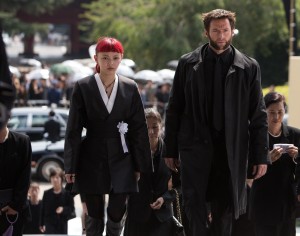
The first X-Men spin-off movie with Hugh Jackman as the super-healing, never-aging mutant who shoots blades out of his knuckles was called “X-Men Origins: Wolverine.” This one is called “The Wolverine.” Got it?
Wolverine is the, well, lone wolf of the X-Men. After a flashback that shows him saving the life of a Japanese soldier as the atomic bomb is dropped on Nagasaki, this chapter opens he is doing the Grizzly Adams thing, living in a cabin on a mountain far from everyone. His dreams are haunted by memories of Jean (Famke Janssen), missing her terribly and consumed with guilt over her death. That is the closest he gets to companionship. Because he does not age, he has witnessed more than a century of tragedy and destruction. He feels guilty for his part in it and he does not have the heart to engage any more. Or so he thinks. A poisoned arrow shot into a bear is enough to provoke his sense of justice. Or his anger, which is close to the same thing.
Out of hiding for a moment is enough time for him to be found by Yukio (Rila Fukushima), a Japanese martial arts specialist with punky red hair. She tells him that the man whose life he once saved is dying and wants him to fly to Japan to say goodbye. He agrees to go for one day, but of course it turns out to be a lot more complicated and dangerous. Wolverine ends up having to rescue Yuikio’s sort-of sister Mariko (a pretty but colorless Tao Okamoto) from some bad guys including a lady with literally poisonous breath and a viper tongue (an unconvincing Svetlana Khodchenkova). One drawback of putting a real actor in the lead role is that is sets the bar pretty high. Jackman has more acting ability and screen presence than anyone else in the film and that throws off the whole movie off balance.
A superhero movie has to have three things: a reason to care about the characters, sensational action scenes, and a really interesting villain. I’d give this movie one out of three. There are some great action scenes, particularly a fight on top of what we’re told is a 300-mile-an-hour bullet train. It is a wonder of split-second timing. And Fukushima is a quick, inventive, and graceful combatant.
Secondary factors are strong as well. Director James Mangold (“Walk the Line”) draws effectively from the visuals of the Japanese atmosphere and setting, though does not make much from the culture beyond a demonstration of how to tie a samurai’s belt and a warning that chopsticks sticking straight up from a bowl are a bad omen. Wolverine has existential conflicts. I’d give a lot for a non-angsty superhero these days, but there is an interesting twist here in tying his reluctance to get involved to the emotional exhaustion of an endless life span. A superhero needs a super-villain, though. Here Wolverine fights a series of interchangeable yakuza thugs in action scenes that are artistically staged, especially one with arrows raining down on Wolverine’s broad shoulders and back, but the pay-off on who is behind it all is scarcely worth it. The real ending to the film comes during the final credits, when we see that what has been missing from this film is promisingly on board for the next installment.
Parents should know that this film includes constant fantasy superhero peril and violence with some graphic injuries and disturbing images, swords, knives, arrows, poison, characters injured and killed, drinking, some strong language (s-words, one f-word), and a non-explicit sexual situation.
Family discussion: What does Wolverine mean when he says he is a soldier? Why was he so isolated at the beginning of the movie and what made him change his mind?
If you like this, try: the “X-Men” movies and comic books
The third in the rock concert trilogy that documented the late 1960’s journey from the innocence of “Monterey Pop” to the hope of “Woodstock” and then the Altamont, where a disastrous decision to have the Hells Angels provide security at a free Rolling Stones concert led to tragedy.
Jagger plays the title character, the real-life Australian outlaw (also played by Heath Ledger in a later film).
This trippy, non-linear crime drama was directed by Nicholas Roeg.
Martin Scorsese directed this documentary with sensational concert footage.
Covering half a century of the Rolling Stones, this documentary has current interviews and archival footage to make it the definitive history — so far.

